Mechanical Feasibility of Asphalt Materials for Pavement Solar Collectors: Small-Scale Laboratory Characterization
Abstract
1. Introduction
2. Research Goals and Approach
- -
- thanks to its conduction properties, a manufactured steel slag aggregate was included in the lithic skeleton (composed by natural limestone aggregate) in order to enhance the thermal conduction within the asphalt layer, and the related solar collector efficiency [26];
- -
- a rather fine aggregate gradation (with nominal maximum aggregate size of 8 mm) was designed to make the mixture structure compatible with the presence of the collector without compromising the functionality of the 4 cm thick covering asphalt layer;
- -
- a low target air-void content was selected for enhancing the thermal transmission within the asphalt layer, since air voids can act as insulators.

3. Materials and Methods
3.1. Constituent Materials
3.2. Samples Preparation
3.3. Testing Methods
3.4. MSCR Data Modelling
4. Experimental Results
5. Conclusions
- -
- with respect to the selected binder (plain 50/70 pen grade non-modified bitumen), the G*/sinδ parameter indicated a PG upper limit almost equal to 52 °C, which can be considered acceptable for such a bitumen;
- -
- the progressive inclusion of lithic fractions, passing from binder to mastic (bitumen + filler with size < 0.075 mm) and fine mortars (bitumen + filler + fine aggregates with size up to 0.18 mm), led to a clear stiffening effect and reduced rutting potential;
- -
- the use of steel-slag fine aggregates at the fine-mortar scale led to an even higher stiffening effect with respect to conventional limestone fine sand, thus suggesting an enhanced rutting resistance;
- -
- slag-based mortar was characterized by a reduced accumulation of high-temperature permanent strains with respect to conventional limestone-based materials, regardless of the testing conditions. Therefore, it can be asserted that the effective use of steel slags should be promoted to achieve environmental, economical, and mechanical benefits;
- -
- the R%, Jnr, and Jnr/Jtot parameters calculated from MSCR test results were not sufficient to fully understand the rutting potential of materials, since the creep-recovery responses could be characterized by different evolutive recoverable strains after load removals;
- -
- a fractional model, constituted by a springpot and a dashpot in series, reliably fitted the evolution of the permanent deformation not only at binder scale, but also at mastic and fine-mortar scale;
- -
- the creep-recovery mechanisms could be also accounted for with simple physical parameters: in particular, the delay in time of the visco-elastic recovery could be a reliable index of the rutting issues, and could be also linked to the material stiffness (the higher the delay, the higher the stiffness and the related rutting resistance).
Author Contributions
Funding
Institutional Review Board Statement
Informed Consent Statement
Data Availability Statement
Conflicts of Interest
References
- Khan, S.; Nagabhushana, M.N.; Tiwari, D.; Jain, P.K. Rutting in flexible pavement: An approach of evaluation with accelerated pavement testing facility. Procedia Soc. Behav. Sci. 2013, 104, 149–157. [Google Scholar] [CrossRef]
- Fwa, T.F.; Pasindu, H.R.; Ong, P. Critical rut depth for pavement maintenance based on vehicle skidding and hydroplaning consideration. J. Civ. Eng. 2012, 138, 423–429. [Google Scholar] [CrossRef]
- Nguyen, T.D.; Le, L.X. Evaluating the possible use of high modulus asphalt mixtures in flexible pavements in Vietnam. Lect. Notes Civ. Eng. 2020, 80, 701–708. [Google Scholar]
- Qinglin, S. Premature Damage and Its Preservative Measures of Bituminous Pavement on Expressway; China Communications Press: Beijing, China, 2009. [Google Scholar]
- Ali, Y.; Irfan, M.; Ahmd, S.; Ahmed, S. Empirical correlation of permanent deformation tests for evaluating the rutting response of conventional asphaltic concrete mixtures. J. Mater. Civ. Eng. 2017, 29, 04017059. [Google Scholar] [CrossRef]
- Coleri, E.; Harvey, J.T.; Yang, K.; Boon, J.M. A micromechanical approach to investigate asphalt concrete rutting mechanisms. Constr. Build Mater. 2012, 30, 36–49. [Google Scholar] [CrossRef]
- Coleri, E.; Harvey, J.T.; Yang, K.; Boon, J.M. Investigation of asphalt concrete rutting mechanisms by X-ray computed; tomography imaging and micromechanical finite element modeling. Mater. Struct. 2013, 46, 1027–1043. [Google Scholar] [CrossRef]
- Li, Q.; Yang, H.; Ni, F.; Ma, X.; Luo, L. Cause analysis on permanent deformation for asphalt pavements using field cores. Constr. Build Mater. 2015, 100, 40–51. [Google Scholar] [CrossRef]
- Su, K.; Sun, L.; Hachiya, Y.; Maekawa, R. Analysis of shear stress in asphalt pavements under actual measured tire-pavement contact pressure. In Proceedings of the 6th International Conference on Road and Airfield Pavement Technology, Sapporo, Japan, 20–23 July 2008. [Google Scholar]
- Song, J.; Pellinen, T. Dilation behavior of hot mix asphalt under triaxial loading. Road Mater. Pavement Des. 2011, 8, 103–125. [Google Scholar]
- Bonaquist, R.F.; Mogawer, W.S. Analysis of pavement rutting data from FHWA pavement testing facility Superpave validation study. Transp. Res. Rec. 1997, 1590, 80–88. [Google Scholar] [CrossRef]
- Zou, G.; Xu, J.; Wu, C. Evaluation of factors that affect rutting resistance of asphalt mixes by orthogonal experiment design. Int. J. Pavement Res. Technol. 2017, 10, 282–288. [Google Scholar] [CrossRef]
- Cheng, J.; Qian, X. Temperature-dependent viscoelastic model for asphalt concrete using discrete rheological representation. Constr. Build Mater. 2015, 93, 157–165. [Google Scholar] [CrossRef]
- Koniditsiotis, C.; Kumar, A. Prediction of road pavement structural capacity from transverse profile shape. In Proceedings of the 6th International Conference on Managing Pavements, Brisbane, Australia, 19–24 October 2004. [Google Scholar]
- El-Badawy, S.; Abd El-Hakim, R. Recent Developments in Pavement Design, Modeling and Performance; Springer: Berlin/Heidelberg, Germany, 2018. [Google Scholar]
- Bahia, H.U.; Hanson, D.I.; Zeng, M.; Zhai, H.; Khatri, M.A.; Anderson, R.M. Characterization of Modified Asphalt Binders in Superpave Mix Design; Transportation Research Board: Washington, DC, USA, 2011. [Google Scholar]
- Choi, Y.K. Visco-elastic analysis of the elastomeric binder shear resistance in relation to asphalt rutting. Road Mater. Pavement Des. 2011, 12, 767–794. [Google Scholar] [CrossRef]
- Javilla, B.; Mo, L.; Hao, F.; An, S.; Wu, S. Systematic comparison of two-stage analytical rutting models of asphalt mixtures. Constr. Build Mater. 2017, 153, 716–727. [Google Scholar] [CrossRef]
- Zairi, H.; Amini, A.; Goli, A.; Mirzaiyan, D. Predicting rutting performance of carbon nano tube (CNT) asphalt binders using regression models and neural networks. Constr. Build Mater. 2018, 160, 415–426. [Google Scholar] [CrossRef]
- Abdullah, G.M.S. 3D finite element modeling to predict the foamed sulfur asphalt marl soil mixes rutting behavior. Ain. Shams Eng. J. 2019, 10, 661–668. [Google Scholar] [CrossRef]
- Underwood, B.S.; Kim, R.Y. Experimental investigation into the multiscale behaviour of asphalt concrete. Int. J. Pavement Eng. 2011, 12, 357–370. [Google Scholar] [CrossRef]
- Gong, X.; Romero, P.; Dong, J.; Li, Y. Investigation on the low temperature property of asphalt fine aggregate matrix and asphalt mixture including the environmental factors. Constr. Build Mater. 2017, 156, 56–62. [Google Scholar] [CrossRef]
- Arega, A.Z.; Bhasin, A.; De Kesel, T. Influence of extended aging on the properties of asphalt composites produced using hot and warm mix methods. Constr. Build Mater. 2013, 44, 168–174. [Google Scholar] [CrossRef]
- Kim, Y.R.; Little, D.N. Development of Specification-Type Tests to Assess the Impact of Fine Aggregate and Mineral Filler on Fatigue Damage; Research Report FHWA/TX-05/0-1707-10; Texas Transportation Institute: Bryan, TX, USA, 2005. [Google Scholar]
- Pasetto, M.; Baliello, A.; Galgaro, A.; Mogentale, E.; Sandalo, A. Preliminary study of an energy harvesting system for road pavements made with marginal aggregate. Lect. Notes Civ. Eng. 2019, 48, 101–113. [Google Scholar]
- Santillán, N.; Speranza, S.; Torrents, J.M.; Segura, I. Evaluation of conductive concrete made with steel slag aggregates. Constr. Build Mater. 2022, 360, 129515. [Google Scholar] [CrossRef]
- Riccardi, C.; Cannone Falchetto, A.; Losa, M.; Wistuba, M. Back-calculation method for determining the maximum RAP content in Stone Matrix Asphalt mixtures with good fatigue performance based on asphalt mortar tests. Constr. Build Mater. 2016, 118, 364–372. [Google Scholar] [CrossRef]
- Airey, G.D.; Collop, A.; Dongre, R. Linear viscoelastic limits of bituminous binders. J. Asph. Paving Technol. 2022, 71, 89–115. [Google Scholar]
- Djurekovic, A.; Mladenovic, G. The Performance of Bitumen Mastics with the Addition of Fly Ash. In Bituminous Mixtures and Pavements VI, 1st ed.; CRC Press: Boca Raton, FL, USA, 2015; pp. 115–122. [Google Scholar]
- Anderson, D.A.; Christenson, D.W.; Bahia, H.U.; Dongre, R.; Sharma, M.G.; Antle, C.E.; Button, J. Binder Characterization and Evaluation. In Vol. 3: Physical Characterization; Strategic Highways Research Program: Washington, DC, USA, 1994. [Google Scholar]
- Williams, M.L.; Landel, R.F.; Ferry, J.D. The temperature dependence of relaxation mechanisms in amorphous polymers and other glass-forming liquids. J. Am Chem. Soc. 1955, 77, 3701–3707. [Google Scholar] [CrossRef]
- Kennedy, T.W.; Huber, G.A.; Harrigan, E.T.; Cominsky, R.J.; Hughes, C.S.; Von Quintus, H.; Moulthrop, J.S. Superior Performing Asphalt Pavements (Superpave): The Product of the SHRP Asphalt Research Program; Strategic Highway Research Program: Washington, DC, USA, 1994. [Google Scholar]
- Cardone, F.; Frigio, F.; Ferrotti, G.; Canestrari, F. Influence of mineral fillers on the rheological response of polymer-modified bitumens and mastics. J. Taff. Transp. Eng. 2015, 2, 373–381. [Google Scholar] [CrossRef]
- Sapora, A.; Cornetti, P.; Carpinteri, A.; Baglieri, O.; Santagata, E. The use of fractional calculus to model the experimental creep-recovery behavior of modified bituminous binders. Mater. Struct. 2016, 49, 45–55. [Google Scholar] [CrossRef]
- Mainardi, F. Fractional Calculus and Waves in Linear Viscoelasticity: An Introduction to Mathematical Models; Imperial College Press: London, UK, 2010. [Google Scholar]
- Caputo, M.; Mainardi, F. Linear Models of Dissipation in Anelastic Solid. La Riv. Del Nuovo Cim. 1971, 1, 161–198. [Google Scholar] [CrossRef]
- Pasetto, M.; Baliello, A.; Giacomello, G.; Pasquini, E. Sustainable solutions for road pavements: A multi-scale characterization of warm mix asphalts containing steel slags. J. Clean Prod. 2017, 166, 835–843. [Google Scholar] [CrossRef]
- D’Angelo, J. The relationship of the MSCR test to rutting. Road Mater. Pavement Des. 2009, 10, 61–80. [Google Scholar] [CrossRef]


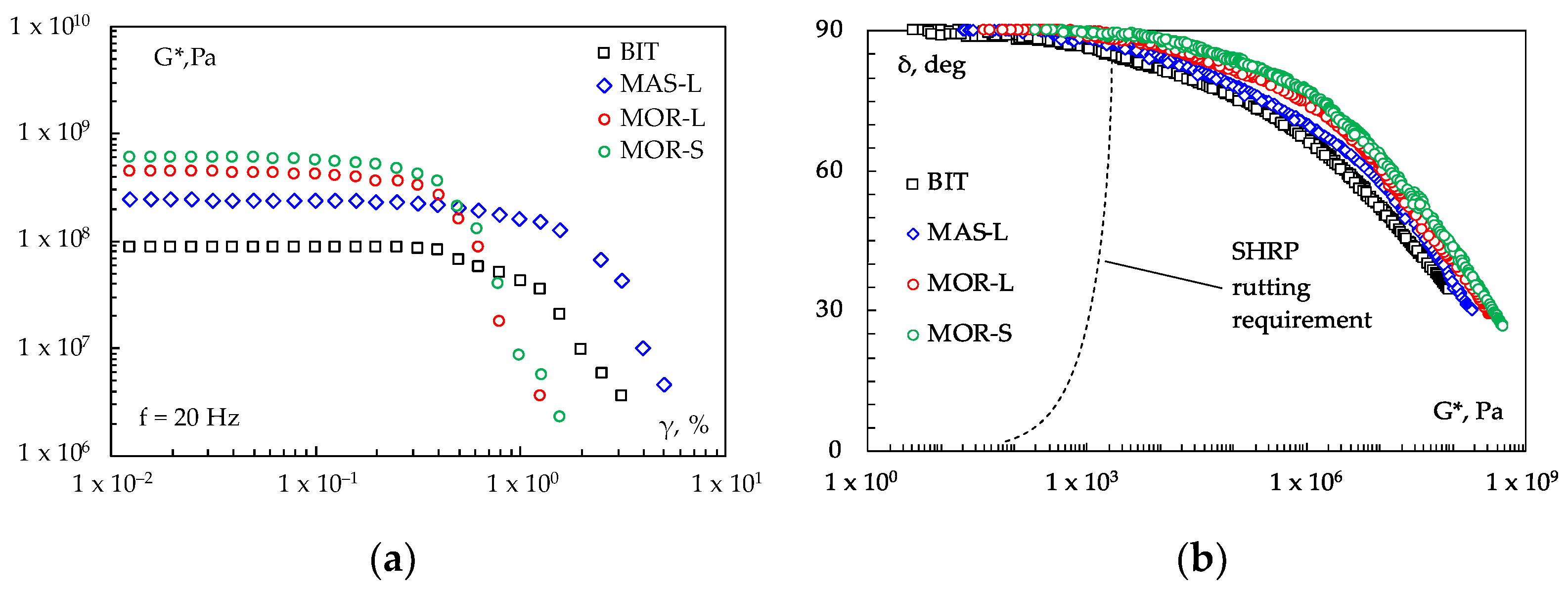
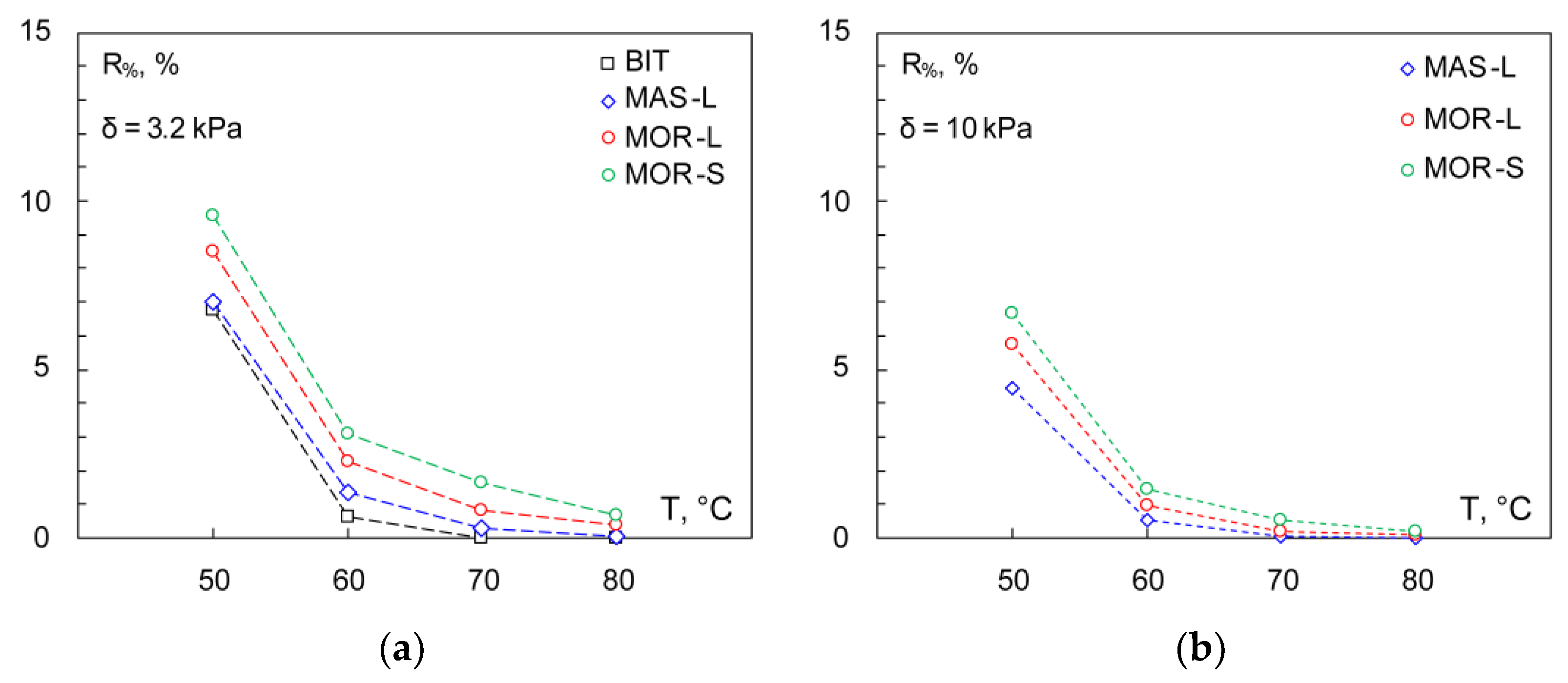
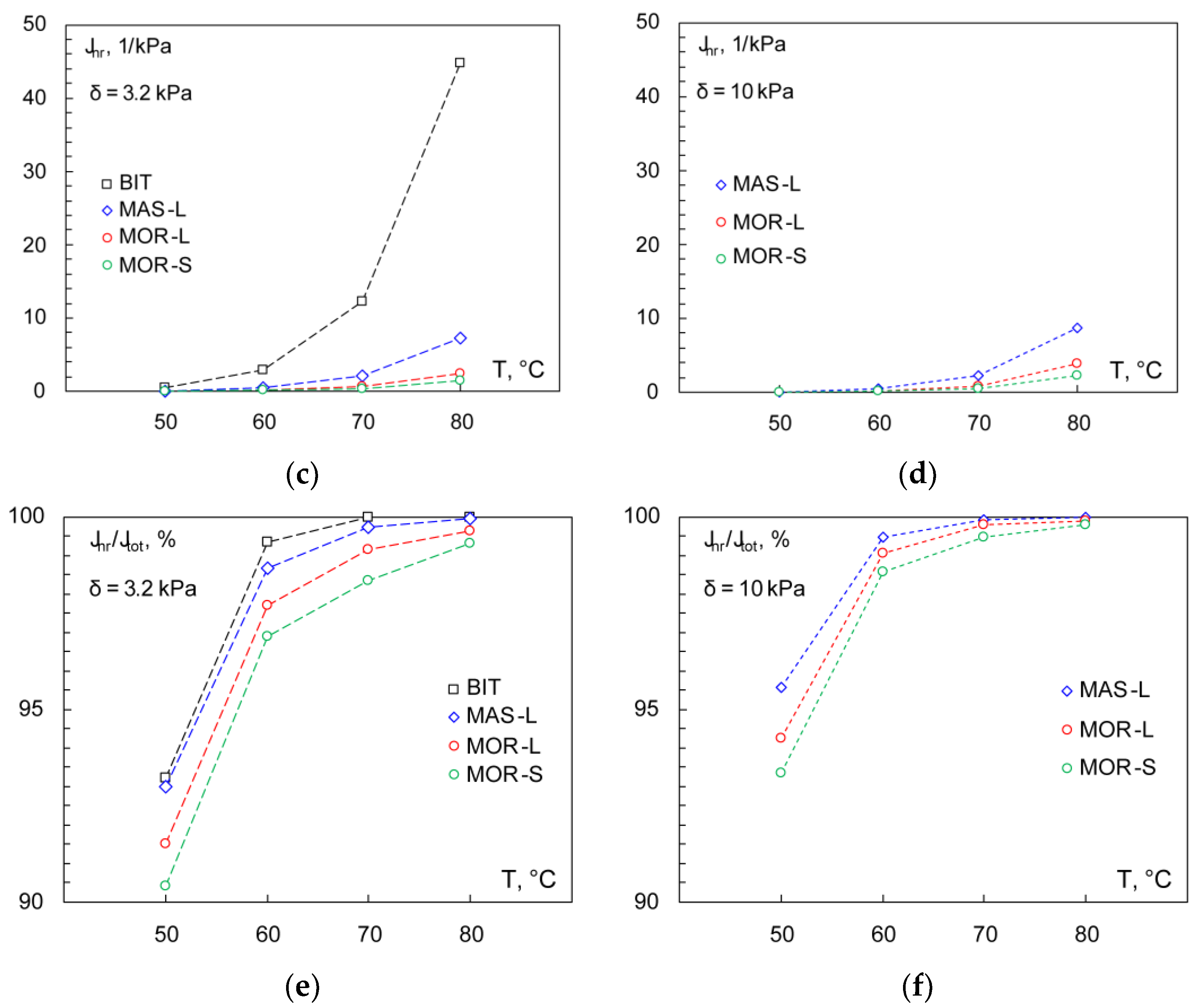
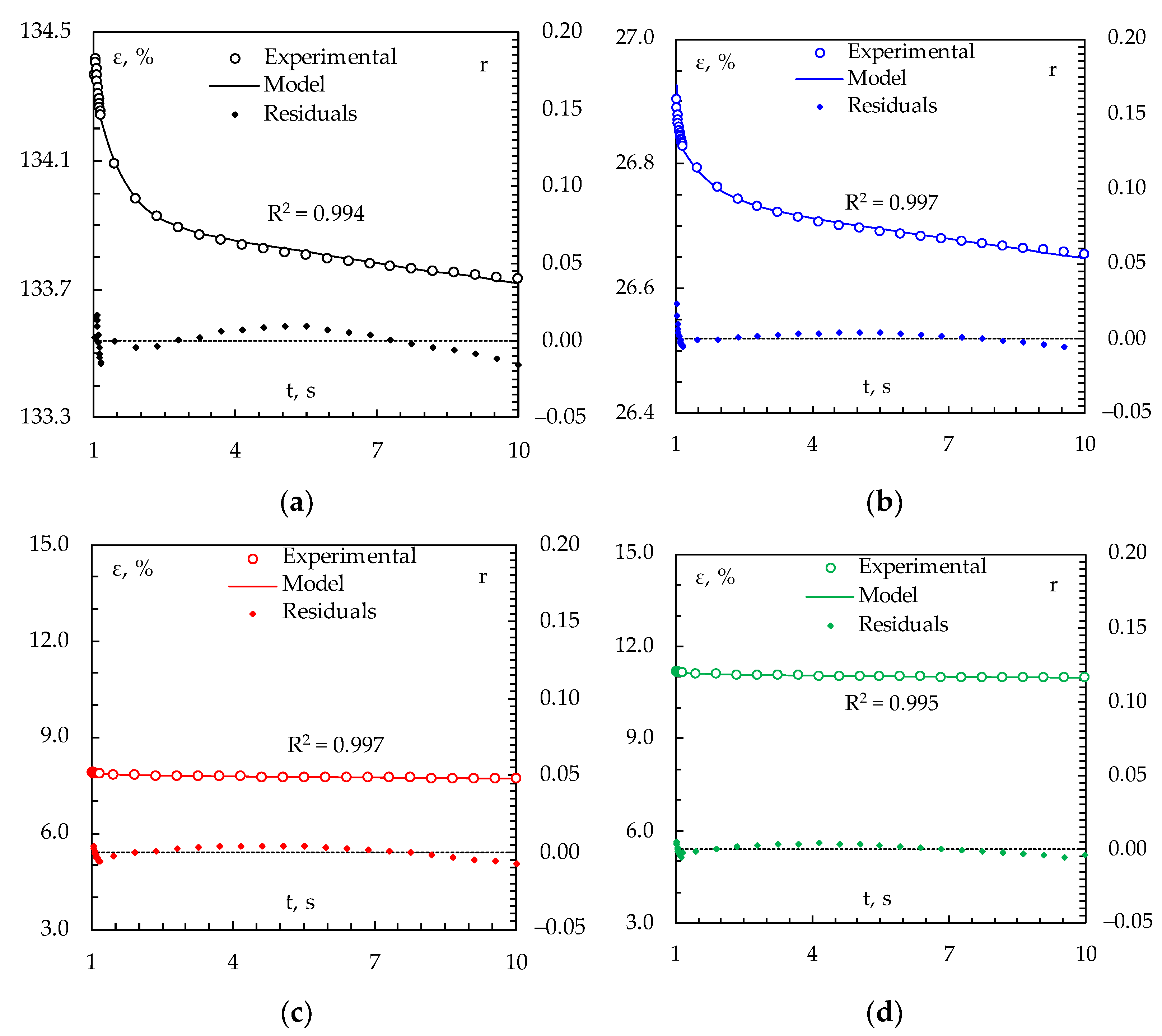
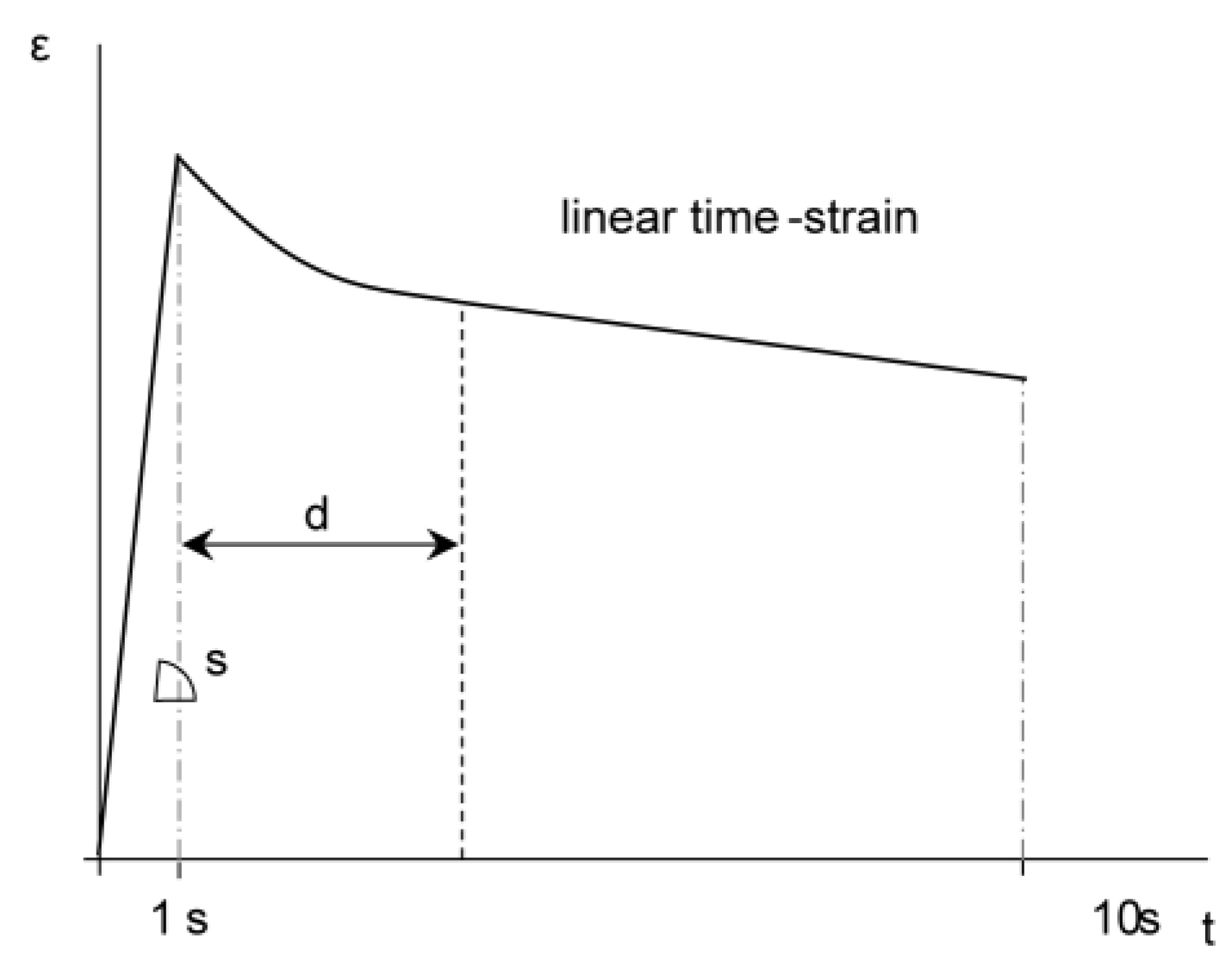
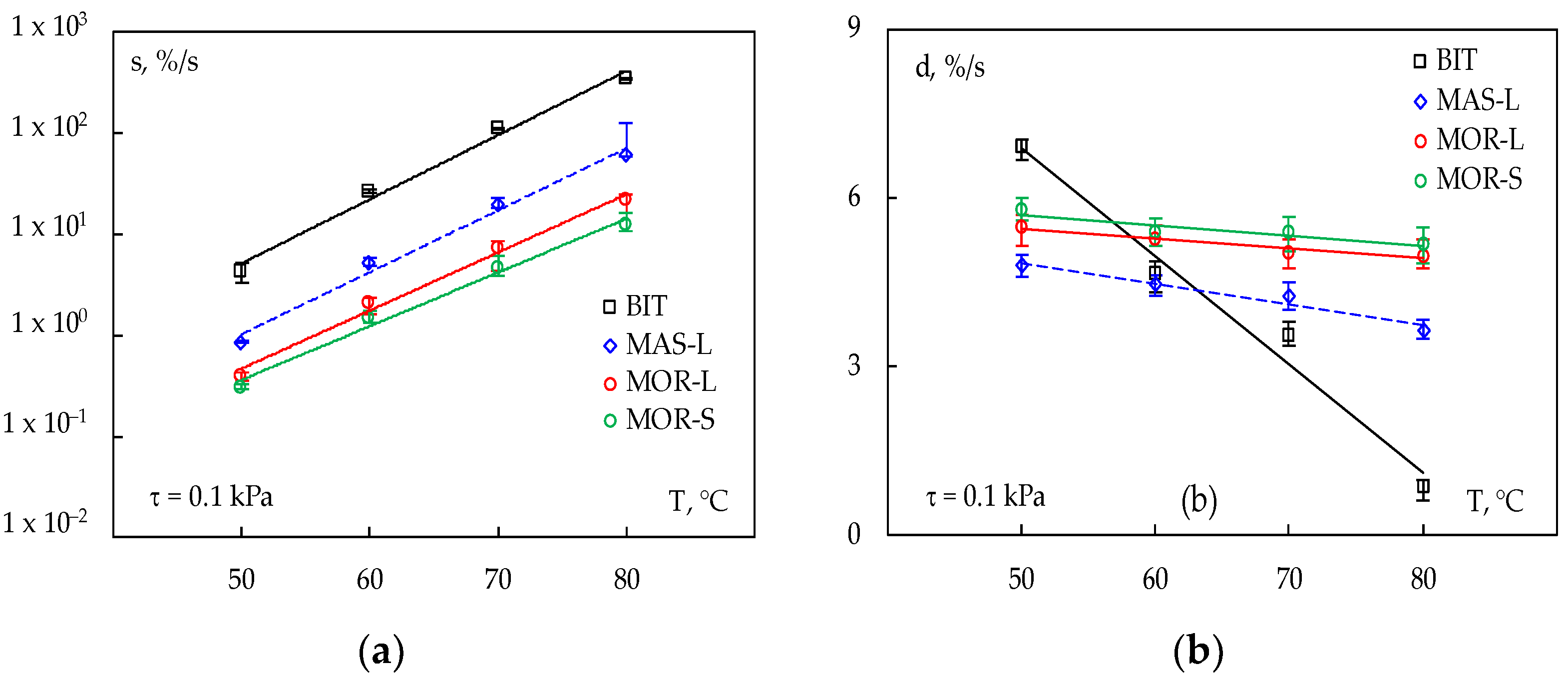
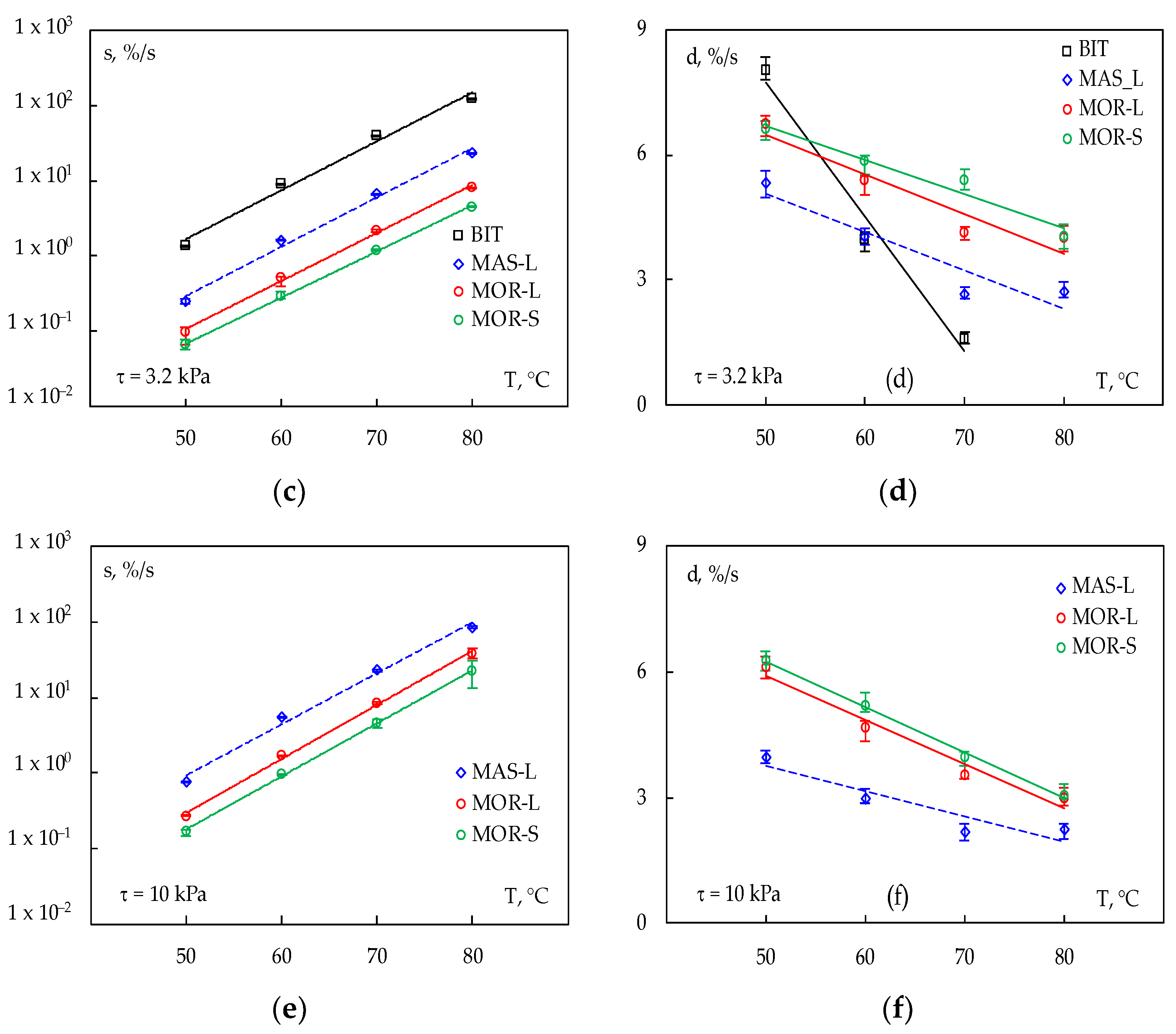
| Characteristic | Test Method | Unit | Value |
|---|---|---|---|
| Penetration at 25 °C | EN 1426 | 0.1 mm | 53 |
| Softening point | EN 1427 | °C | 50.0 |
| Retained pen. at 25 °C after RTFO | EN 1426 | % | 70 |
| Increase in soft. point after RTFO | EN 1427 | °C | 6.6 |
| Ductility at 25 °C | ASTM D113 | cm | >100 |
| Characteristic | Test Method | Unit | Value | |
|---|---|---|---|---|
| Limestone | Steel Slag | |||
| Particle density | EN 1097-6 | Mg/m3 | 2.76 | 3.84 |
| Shape index | EN 933-4 | % | 12.8 | 7.8 |
| Flakiness index | EN 933-3 | % | 10.5 | 8.3 |
| Sand equivalent | EN 933-8 | % | 78 | 92 |
| Rigden voids | EN 1097-4 | % | 32.7 | – |
| Aggregates | Oxide Content [%] | |||||||
|---|---|---|---|---|---|---|---|---|
| MgO | Al2O3 | SiO2 | CaO | TiO2 | Cr2O3 | MnO | FeO | |
| L | 2.50 | 1.00 | 3.34 | 52.71 | – | – | – | 0.39 |
| S | 3.65 | 9.30 | 13.02 | 29.60 | 0.35 | 4.03 | 5.09 | 32.84 |
| Temperature [°C] | ||||||||||||
|---|---|---|---|---|---|---|---|---|---|---|---|---|
| 15 | 20 | 25 | 30 | 35 | 40 | 45 | 50 | 55 | 60 | 75 | 80 | |
| G* [kPa] | 10,573 | 3610 | 1092 | 300 | 79.83 | 23.30 | 7.46 | 3.10 | 1.22 | 0.68 | 0.30 | 0.12 |
| Δ [deg] | 51.37 | 59.18 | 66.33 | 72.20 | 76.46 | 79.80 | 82.43 | 84.51 | 86.02 | 87.00 | 88.24 | 88.50 |
| G*/sinδ [kPa] * | 13,535 | 4204 | 1192 | 315 | 82.11 | 23.67 | 7.53 | 3.11 | 1.23 | 0.68 | 0.30 | 0.12 |
| BIT | ||||||||||||
|---|---|---|---|---|---|---|---|---|---|---|---|---|
| T [°C] | 50 | 50 | 50 | 60 | 60 | 60 | 70 | 70 | 70 | 80 | 80 | 80 |
| τ [kPa] | 0.1 | 3.2 | 10 | 0.1 | 3.2 | 10 | 0.1 | 3.2 | 10 | 0.1 | 3.2 | 10 |
| α [-] | 0.498 | 0.471 | - | 0.387 | 0.0001 | - | 0.984 | 0.945 | - | 0.999 | n.a. * | - |
| b1 [-] | 215.2 | 271.2 | - | 104.8 | 0.0006 | - | 3.145 | 343.1 | - | 0.062 | n.a. * | - |
| b2 [-] | 5.056 | 4.688 | - | 0.748 | 0.666 | - | 0.187 | 0.154 | - | 0.205 | n.a. * | - |
| SSE R2 | 0.999 | 0.998 | - | 0.994 | 0.977 | - | 0.990 | 0.826 | - | 0.986 | n.a. * | - |
| MAS-L | ||||||||||||
| T [°C] | 50 | 50 | 50 | 60 | 60 | 60 | 70 | 70 | 70 | 80 | 80 | 80 |
| τ [kPa] | 0.1 | 3.2 | 10 | 0.1 | 3.2 | 10 | 0.1 | 3.2 | 10 | 0.1 | 3.2 | 10 |
| α [-] | 0.784 | 0.536 | 0.414 | 0.688 | 0.203 | 0.188 | 0.951 | 0.617 | 0.0001 | 0.991 | 0.990 | n.a. * |
| b1 [-] | 460.1 | 1398 | 2468 | 311.8 | 1026 | 2691 | 38.55 | 1252 | 0.048 | 4.941 | 70.25 | n.a. * |
| b2 [-] | 26.68 | 24.73 | 15.96 | 3.768 | 3.748 | 2.285 | 1.005 | 0.9043 | 0.548 | 0.332 | 0.265 | n.a. * |
| SSE R2 | 0.999 | 0.998 | 0.994 | 0.997 | 0.997 | 0.993 | 0.991 | 0.970 | 0.767 | 0.994 | 0.922 | n.a. * |
| MOR-L | ||||||||||||
| T [°C] | 50 | 50 | 50 | 60 | 60 | 60 | 70 | 70 | 70 | 80 | 80 | 80 |
| τ [kPa] | 0.1 | 3.2 | 10 | 0.1 | 3.2 | 10 | 0.1 | 3.2 | 10 | 0.1 | 3.2 | 10 |
| α [-] | 0.876 | 0.571 | 0.544 | 0.920 | 0.653 | 0.709 | 0.942 | 0.918 | 0.912 | 0.943 | 0.986 | n.a. * |
| b1 [-] | 361.3 | 2715 | 5180 | 120.6 | 2278 | 4971 | 58.34 | 488.5 | 452.3 | 21.29 | 49.11 | n.a. * |
| b2 [-] | 63.88 | 57.42 | 42.41 | 9.692 | 11.17 | 7.184 | 2.466 | 2.726 | 0.512 | 0.848 | 0.782 | n.a. * |
| SSE R2 | 0.999 | 0.999 | 0.998 | 0.997 | 0.995 | 0.995 | 0.996 | 0.989 | 0.991 | 0.993 | 0.879 | n.a. * |
| MOR-S | ||||||||||||
| T [°C] | 50 | 50 | 50 | 60 | 60 | 60 | 70 | 70 | 70 | 80 | 80 | 80 |
| τ [kPa] | 0.1 | 3.2 | 10 | 0.1 | 3.2 | 10 | 0.1 | 3.2 | 10 | 0.1 | 3.2 | 10 |
| α [-] | 0.914 | 0.621 | 0.623 | 0.942 | 0.824 | 0.897 | 0.991 | 0.998 | 0.999 | 0.934 | 0.999 | 0.999 |
| b1 [-] | 385.9 | 3114 | 6363 | 101.7 | 2771 | 5459 | 68.59 | 13.41 | 12.37 | 28.79 | 4.655 | 9.455 |
| b2 [-] | 110.5 | 76.92 | 61.16 | 14.55 | 17.76 | 12.39 | 5.853 | 7.445 | 3.744 | 1.310 | 1.895 | 0.761 |
| SSE R2 | 0.994 | 0.999 | 0.999 | 0.995 | 0.995 | 0.993 | 0.988 | 0.990 | 0.984 | 0.969 | 0.996 | 0.879 |
| Material | τ [kPa] | s | d | ||||
|---|---|---|---|---|---|---|---|
| A | B | R2 | m | q | R2 | ||
| BIT | 0.1 | 0.0035 | 0.1461 | 0.9875 | −0.1937 | 16.586 | 0.9775 |
| 3.2 | 0.0943 | 0.1496 | 0.9869 | −0.3225 | 23.863 | 0.9776 | |
| MAS-L | 0.1 | 0.0009 | 0.1411 | 0.9886 | −0.0365 | 6.675 | 0.9553 |
| 3.2 | 0.0155 | 0.1509 | 0.9907 | −0.092 | 9.6559 | 0.8854 | |
| 10 | 0.0383 | 0.1560 | 0.9910 | −0.0601 | 6.7586 | 0.8569 | |
| MOR-L | 0.1 | 0.0006 | 0.1324 | 0.9898 | −0.0177 | 6.338 | 0.9524 |
| 3.2 | 0.0069 | 0.1469 | 0.9973 | −0.0947 | 11.213 | 0.9149 | |
| 10 | 0.0077 | 0.1651 | 0.9979 | −0.1058 | 11.217 | 0.9675 | |
| MOR-S | 0.1 | 0.0008 | 0.1224 | 0.9885 | −0.0183 | 6.6292 | 0.8581 |
| 3.2 | 0.0058 | 0.1413 | 0.9995 | −0.0816 | 10.759 | 0.9529 | |
| 10 | 0.0055 | 0.1619 | 0.9994 | −0.1087 | 11.698 | 0.9966 | |
Disclaimer/Publisher’s Note: The statements, opinions and data contained in all publications are solely those of the individual author(s) and contributor(s) and not of MDPI and/or the editor(s). MDPI and/or the editor(s) disclaim responsibility for any injury to people or property resulting from any ideas, methods, instructions or products referred to in the content. |
© 2022 by the authors. Licensee MDPI, Basel, Switzerland. This article is an open access article distributed under the terms and conditions of the Creative Commons Attribution (CC BY) license (https://creativecommons.org/licenses/by/4.0/).
Share and Cite
Pasetto, M.; Baliello, A.; Giacomello, G.; Pasquini, E. Mechanical Feasibility of Asphalt Materials for Pavement Solar Collectors: Small-Scale Laboratory Characterization. Appl. Sci. 2023, 13, 358. https://doi.org/10.3390/app13010358
Pasetto M, Baliello A, Giacomello G, Pasquini E. Mechanical Feasibility of Asphalt Materials for Pavement Solar Collectors: Small-Scale Laboratory Characterization. Applied Sciences. 2023; 13(1):358. https://doi.org/10.3390/app13010358
Chicago/Turabian StylePasetto, Marco, Andrea Baliello, Giovanni Giacomello, and Emiliano Pasquini. 2023. "Mechanical Feasibility of Asphalt Materials for Pavement Solar Collectors: Small-Scale Laboratory Characterization" Applied Sciences 13, no. 1: 358. https://doi.org/10.3390/app13010358
APA StylePasetto, M., Baliello, A., Giacomello, G., & Pasquini, E. (2023). Mechanical Feasibility of Asphalt Materials for Pavement Solar Collectors: Small-Scale Laboratory Characterization. Applied Sciences, 13(1), 358. https://doi.org/10.3390/app13010358












